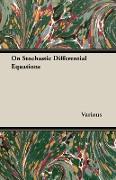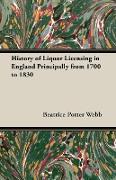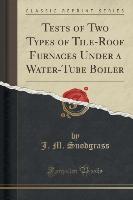On Stochastic Differential Equations
BücherAngebote / Angebote:
MEMOIRS O F T H i-AMERICAN MATHEMATICAL SOCIETY NLMBKR 4 ON STOCHASTIC DlFFliRL. NT. lAL LUAUONS KFYOSl 1TO PUBLISHED BY THh AMERICAN MATHEMATFCAL SCXJF1T 531 West 116th St., New York City ON STOCHASTIC DIFFERENTIAL EQUATIONS By KIYOSI ITO Let Xj. be a simple Markoff process with a continuous parameter t, and F t, s, E be the transition probability law of the process D F t, , -s, E - Prfx E X.-3, where the right side means the probability of x a E under the condition x. f Hie differential of x. at t s is given by the transition probability law of x in an infinitesimal neighborhood of t s 2 FCs-A jjs E. W. Feller has discussed the case in which it has the following form 3 F s-A 2 , JJS A E 1-p s, I yA 2 G s-A 2 , j js A E yA 2 p s, j P s, 3 , E o yA 2 , where G s-Ag, 5 s A, j, E is a probability distribution as a function of E and satisfies 5 T- T f 1 2 J -j h-jl f 6 2 J, l-J G s-A 2 , J js dn - b t, J, for A A and p s, J and P s, J , E is a probability distribution in E. The special case of M p s, J O 11 has already been treated by A, Kolmogoroff and S. Bernstein. 3 We shall introduce a somewhat general definition of the differential of the process x. Cf. 85. Let P A denote the conditional probability law L 8, 5 , , 2 Mx-V E-3 , A V A 2 0. If the 1 A -times convolution of P fl A tends to a probability law L with regard to Levys law-distance as A A 0, then L is called the I d S, J stochastic differential coefficient at s. L is clearly an infinitely divisible law. In the above Fellers case the logarithmic characteristic function Received by the editors March 29, 5 KIYOSI I TO V , L S of L f is given by 7 z, L ib s, j z - a s, j z p s, 5 f 03 e iu2 - 1 P s, J , du J . 6 8 j 7 - 00 A problem of stochastic differential equations is to construct a Markoff process whose stochastic differential coefficient L. - is given as a function of t, . 9 W. Feller has deduced the following integro-differential equation from 3, 4, 5 and 6 F t, J s, E - P t, j F t, J s, E p t, f F t, 7 s, E P t, J , dT 0. He has proved the J-oo existence and uniqueness of the solution of this equation under some conditions and has shown that the solution becomes a transition probability law, and satisfies 3, 4, 5 6. He has termed the case p t, j as continuous case and the case a t, J and b t, J as purely discontinuous case. It is true that we can construct a simple Markoff process from the transition probability law by introducing a probability distribution into the functional space RR by Kolmogoroff f s theorem, 7 but it is impossible to discuss the regularity of the ob tained process, for example measurability, continuity, discontinuity of the first kind etc, , as was pointed out by J. L, Doob. 8 To discuss the measurability of the process for example, J, L. Doob has introduced a probability distribution on a subspace of RR and E, Slutsky has introduced a new concept tf measurable kernel 1 , 9 We shall in vestigate the sense of the term lf continuous case 11 and fl purely discontinuous case 11 used by W, Feller from the rigorous view-point of J. L. Doob and E. Slutsky. A recent research of J, L, Doob O concerning a simple Markoff process taking values in an en umerable set has been achieved from this view-point, A research of R. FortetH con cerning the above continuous case seems also to stand on the same idea but the author is not yet informed of the details . In his paper ON STOCHASTIC PROCESSES I 11 12 the author has deduced Levys canonical form of differential processes with no fixed discontinuities by making use of the rigorous scheme of J. L, Doob, Using the results of the above paper, we shall here construct the solution of the above stochastic differential equation in such a way that we may be able to discuss the regularity of the solution. For this purpose we transform the stochastic differential equation into a stochastic integral . equation...
Folgt in ca. 10 Arbeitstagen




